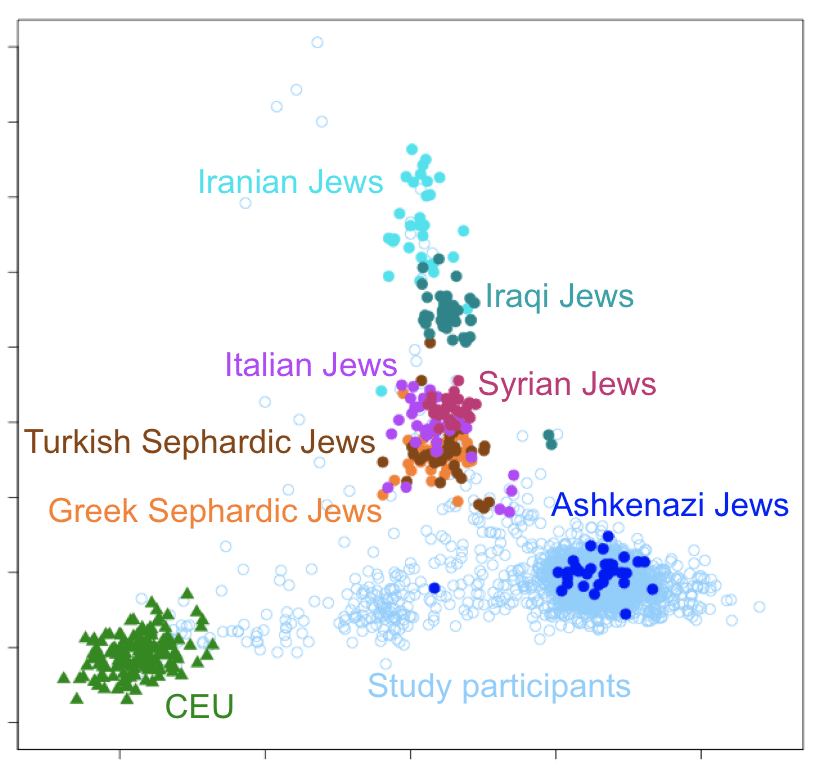Editor’s note: (June 4, 2024) This blog post has been updated from the original.
The history and culture of Ashkenazi Jewish people, the waves of persecution, pogroms, and communal isolation over centuries help explain the genetic uniqueness of Ashkenazi ancestry and its implications on health.
While people of Ashkenazi ancestry have deep roots in Eastern and Central Europe, their ancestral lines trace back further to areas in the Middle East.
For people of Ashkenazi ancestry, it is in Europe that a drastic reduction in the population’s size and communal isolation became so profound that they created what geneticists call a “population bottleneck.”
Factors like disease outbreaks, geographic isolation, mass migration, and persecution can all contribute to population bottlenecks. This was particularly true for Ashkenazi Jewish communities, who faced centuries of discrimination and displacement. Such events drastically reduce a population’s size, limiting its genetic diversity. Over generations, this can lead to distinct genetic characteristics and a higher prevalence of certain inherited conditions within the Ashkenazi Jewish population.
That happened among Ashkenazi Jewish communities in Central and Eastern Europe. Our DNA Health + Ancestry Service can help you learn more about your ancestry and genetic health.
Ashkenazi Ancestry and Risk for Certain Genetic Conditions
Understanding this history of isolation helps explain why people with Ashkenazi ancestry are more likely to carry genetic variants that cause certain single-gene recessive Mendelian conditions such as Gaucher disease, Canavan disease, and Tay-Sachs disease.
In addition, people with Ashkenazi ancestry are more likely to carry the so-called “founder variants” in the BRCA1 and BRCA2, increasing the risk of breast, ovarian, and prostate cancer.
It also helps explain why people of Ashkenazi Jewish ancestry are more than twice as likely to develop Crohn’s disease compared to those of other European ancestry.
Tracing the History of Ashkenazi Jewish Ancestry
People of Ashkenazi ancestry first migrated to Southern Europe from Western Asia around 2,000 years ago.
Then — in the Middle Ages — many Jewish people living in southern Europe moved north. They primarily settled in northeastern France and western Germany near the Rhine River. It was there that their distinct religious, cultural, and Ashkenazi Jewish identity formed.
The word “Ashkenazi” is thought to come from the name “Ashkenaz,” a descendant of Noah named in the Hebrew Bible.
Although Ashkenazi Jewish ancestry is under the umbrella of “European ancestry,” it’s clear from numerous studies that people of Ashkenazi ancestry are distinct from other European populations.
Ashkenazi Ancestry and Other Jewish Ancestry
While most people with Ashkenazi ancestry trace their DNA to Eastern and Central Europe, they are often more genetically like other Jewish populations — such as Sephardic Jews or Jewish groups with roots in Iran, Iraq, or Syria — than other Europeans.
People with European ancestry are genetically distinct from those of Asian or African descent. What is less obvious is that genetic variation also exists within European groups.


In these plots from a study by Eimear Kenny, you can see the genetic variation between major ancestral groups (left) and within a population (right). Jewish groups fall into the European cluster on the left.
But people with Ashkenazi ancestry (blue) form a unique cluster. That cluster is distinct mainly from Caucasian (CEU; green) and other Jewish populations (various colors) on the right. Individuals who are part Ashkenazi fall between the Caucasian and Ashkenazi clusters.
Persecution, Isolation, and the Ashkenazi Genetic Bottleneck
What contributed to those differences was the unique history of the Ashkenazi people. During their long history in Europe, Ashkenazi Jews faced waves of persecution and cultural isolation that, in turn, impacted their genetics.
Starting in the 11th Century during the Christian Crusades, Jews living in primarily northwestern Europe were not just persecuted but, in some communities, massacred. Other communities in England and France, for instance, were expelled.
Fleeing from that violence and persecution, many Ashkenazi Jewish people migrated east to places like present-day Poland and Lithuania. The violence and the plague, which hit Europe in the 14th and 15th Centuries, decimated the Ashkenazi Jewish population.
Some estimate that it plummeted by close to 90 percent. This created a population bottleneck so that most of the 10 million Ashkenazi Jewish people living today are related to a few hundred “founding individuals.”
To illustrate the impact of that isolation, two people of Ashkenazi descent in 14th-century Germany were more genetically distinct than the average two Ashkenazi Jewish people living today.
While the persecution and isolation that created the population bottleneck happened in the Middle Ages, the persecution of Jewish people did not end then.
In the 20th Century, more than six million European Jewish people were systematically murdered in the Holocaust. Many who survived the Holocaust immigrated to the United States and Israel after the war.
Explore Your Ancestry with 23andMe
Learn if your genetics might Increase your risk for any health conditions with 23andMe.
23andMe customers can go to their Ancestry Overview and learn specific insights into whether they have Ashkenazi ancestry.
Are you still waiting to be a customer? Find out more about 23andMe’s ancestry offerings here.
Knowing your ancestry can teach you about your family’s heritage and is vital for your health.
With our health + Ancestry service, you can learn more about your ancestry and genetic health. Find out more here.




